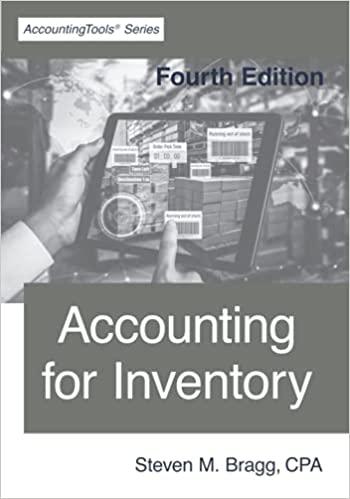Question
1. the right of common shareholders to protect their proportionate interest in a corporation by having the first opportunity to buy additional proportionate shares of
1. the right of common shareholders to protect their proportionate interest in a corporation by having the first opportunity to buy additional proportionate shares of common stock issued by the corporation is called a
a. preemptive right
b. proxy rigt
c. right to call
d. financial leverage
2. a bond issued a discount indicates that at the date of issue
a. its contract (coupon) rate was lower than the prevailing market rate of interest on similar bonds
b. its contract (coupon) rate was higher than the prevailing market rate of interest on similar bonds
c. the bonds were issued at a price greater than their face value
d. the bonds are non interest bearing
3. which of the following will cause the total number of stock outstanding to of a corporation to increase?
a. stock dividend
b. cash dividend
c. both a cash dividend and a stock dividend
d. neither a cash dividend nor stock dividend
4. stock that was reacquired and is still held by the issuing corporation is called
a. capital stock
b. treasury stock
c. preferred stock
d. callable stock
5. on jan 1, $400,000 of par value bonds with a carrying value of $420000 is converted to 40,000 shares of $8 par value common stock. the entry to record the conversion of the bonds includes all of the following entries except
a. debit to bonds payable $420,000
b. debit to premium on bonds payable $20,000
c. credit to common stock $320,000
d, credit to paid in capital in excess of par value, common stock $100,000
6. a partnership recorded the following journal entry:
cash 70,000
B tanner capital 10,000
r jackson capital 10,000
H rivera capital 90,000
the entry reflects
a. acceptance of a new partner who invest $70,000 and recieves a additional $10,000 bonus
b. addition of a partnery who pays a bonus to each of the other partners
c. additional investment into the partnership by tanner and jackson
d. withdrawal of a partner who pays a $10000 bonus to each of the other partners
7. a proxy is
a. a contractual commitment by an investor to purchase unissued shares of stock
b. an amount of assets defined by state law that stockholders must invest and leave invested in a corporaiton
c. the right of common stockholders to protet their proportionate interests in a corporation by having the first opportunity to purchase additional shares of common stock issued by the corporation
d. a document that gives a designated agent of a stockholder the right to vote the stock
8. amortizing a bond discount
a. increases the market value of the bonds payable
b. decreases the bonds payable account
c. allocates a portion of the total discount to interest expense each interest period
d. increases cash flows from the bond
9. the characteristic of a partnership that each partner may be called on to pay all of the partnership debts is known as
a. mutual agency
b. voluntary association
c. preemptive right
d. unlimited libaility
10. a company received cash proceeds of $206948 on a bond issue with a par value of $200,000. the difference between par value and the issue price for this bond is recorded as a
a. credit to interest income
b. credit to discount on bonds payable
c. credit to premium on bonds payable
d. debit to premium on bonds payable
11. a company issued 8% 15 year bonds with a par value of $550,000. the current market rate is 8%. the journal entry to record each semiannual interest payment is
a. debit bond interest expense $44000; credit cash $44000
b. debit bond interest expense $22000, credit cash $22000
c. debit bond interest expense $36667; credit cash $36667
d. no entry needed since no interest is paid until bond is due
12. the contract between the bond issuer and bondholders identifying the rights and obligations of the parties is called a
a. debenture
b. bond indenture
c. mortgage
d. convertible bonds
13. a partnership is liquidating their business. the partners have shared any profits and losses equally. after selling non cash assets, allocating all profits or losses and paying any liabilities the partnership has the following balance sheet. the partners have shared profits and losses equally.
Cash 32,000 Douglas, capital 20,000
Grayson, capital 12,000
32,000
how much cash would be given to douglas in the final distribution of cash?
a. $4000
b. $36000
c. $20000
d. $12000
Step by Step Solution
There are 3 Steps involved in it
Step: 1

Get Instant Access to Expert-Tailored Solutions
See step-by-step solutions with expert insights and AI powered tools for academic success
Step: 2

Step: 3

Ace Your Homework with AI
Get the answers you need in no time with our AI-driven, step-by-step assistance
Get Started


